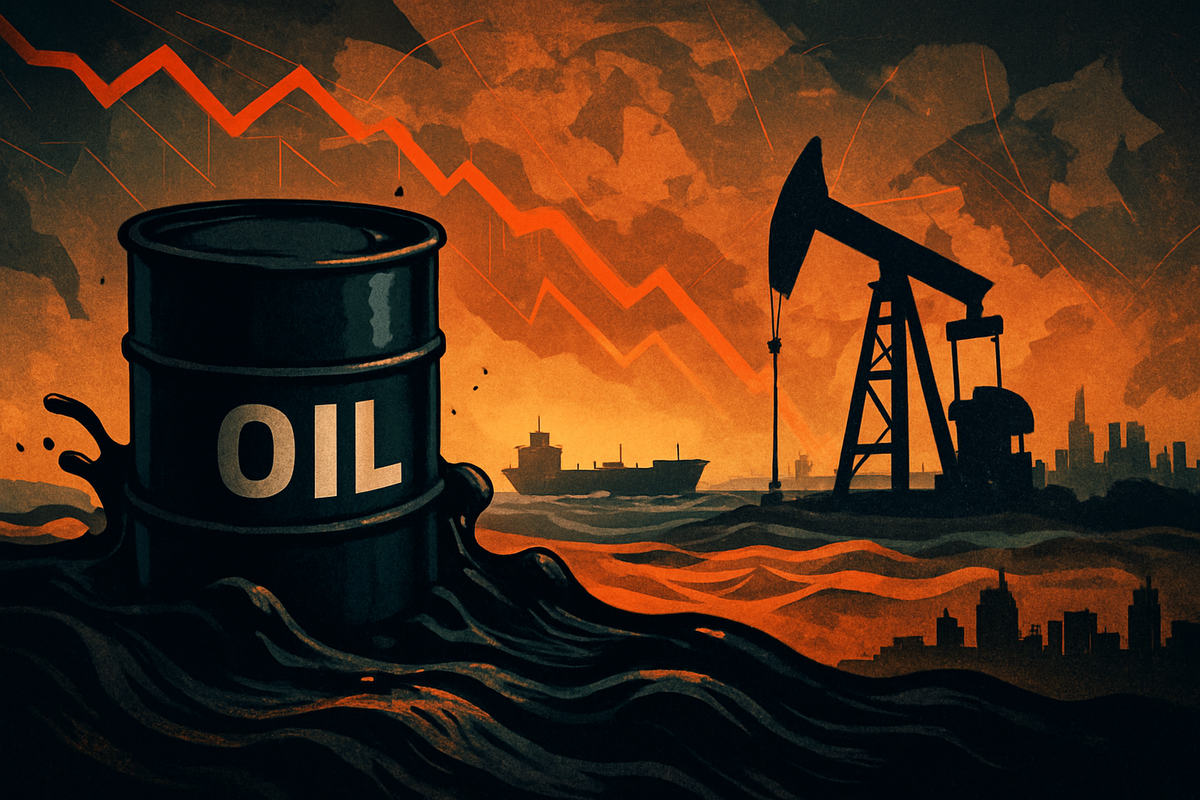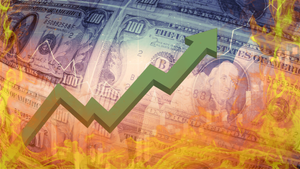
The global crude oil market is currently navigating a complex landscape in October 2025, marked by an anticipated significant downturn in prices despite persistent geopolitical tensions. After a period of relative stability in the third quarter, both West Texas Intermediate (WTI) and Brent crude benchmarks have recently hit four-month lows, signaling a bearish outlook for the remainder of the year and into early 2026. This shift is primarily driven by a robust increase in global supply, particularly from non-OPEC+ nations, coupled with a moderating global demand growth and rising inventories.
This immediate price pressure, however, is juxtaposed against a backdrop of heightened geopolitical risks in the Middle East and ongoing fallout from the Russia-Ukraine conflict, which continue to inject volatility and maintain a risk premium in the market. The delicate balance between fundamental supply-demand dynamics and unpredictable geopolitical events is shaping a challenging environment for energy producers, consumers, and policymakers alike.
Market Dynamics and Geopolitical Undercurrents Shape Crude's Trajectory
The crude oil market in October 2025 is undergoing a notable transformation, moving from a period of relative stability to one of anticipated decline. Brent crude, which averaged around $70 per barrel in July before slipping to $67-$68 in August and September, has further dipped to approximately $64-$65 per barrel. Similarly, WTI crude is now trading around $61-$62 per barrel. Forecasts from the U.S. Energy Information Administration (EIA) paint an even starker picture, predicting Brent crude could fall to an average of $59 per barrel in Q4 2025 and potentially reach $49 per barrel by March-April 2026. WTI is expected to follow a similar trajectory, dropping to $58 per barrel by Q4 2025 and around $50 per barrel in early 2026. This marks a significant reversal from earlier in the year when prices were considerably higher, near $82 per barrel.
Several key factors are converging to drive this bearish sentiment. The Organization of the Petroleum Exporting Countries and its allies (OPEC+) have been gradually unwinding their voluntary output cuts, which were initially implemented in late 2022 and extended through early 2025. Starting in April 2025, OPEC+ began a phased increase in production, with a modest increase of 137,000 barrels per day (bpd) agreed for November, following a similar rise in October. While a strategic move to regain market share, this unwinding is occurring slower than the growth in non-OPEC+ supply, exacerbating concerns of market oversupply.
A significant portion of this increased global supply is attributed to robust production growth from non-OPEC+ producers. The United States, in particular, has demonstrated remarkable resilience, with its crude oil output reaching a record of over 13.6 million bpd in July 2025, and projections indicating an average of 13.5 million bpd through 2026. Other nations like Brazil, Canada (TSX: CNQ), and Guyana (NYSE: HES) are also contributing substantially to the surge in global production. Simultaneously, global oil demand growth is moderating, projected to increase by only 740,000 bpd year-on-year in 2025. While demand in advanced economies showed resilience in H1 2025, it is expected to contract in the latter half of the year. Muted consumption in emerging economies, notably China (SSE: 601857) where deliveries fell short in July, and macroeconomic headwinds such as persistent high interest rates, are further dampening overall energy consumption. Consequently, global observed oil inventories have been steadily rising and are expected to continue building significantly through late 2025 and 2026, creating a major downward pressure on prices.
Geopolitical tensions, while sometimes offset by fundamental supply/demand dynamics, remain a critical wildcard, adding a risk premium and contributing to market volatility. Ongoing conflicts in the Middle East, including those involving Israel-Iran and Israel-Hamas, continue to create supply chain risks and price spikes, such as the brief surge in Brent crude prices in June 2025 due to an Israel-Iran conflict. The ever-present threat of a closure of the Strait of Hormuz, a crucial chokepoint for global oil and LNG trade, represents a severe risk that could drastically impact prices. In a significant development in October 2025, UN sanctions against Iran were formally reinstated through a "snapback" mechanism initiated by Britain, France, and Germany, prohibiting imports and exports of Iranian oil. Although China and Russia have dismissed these sanctions and pledged continued energy cooperation with Iran, their long-term effectiveness could influence global supply. The Russia-Ukraine conflict also continues to disrupt Russian crude supply, with recent drone attacks on Russia's Kirishi oil refinery temporarily halting operations and tightening near-term supply. The United States has also levied tariffs on India for purchasing Russian crude, indicating ongoing disruptions to traditional trade flows.
Corporate Fortunes Diverge: Winners and Losers in a Volatile Oil Market
The current crude oil market, characterized by falling prices and abundant supply, is creating a clear divergence in fortunes for public companies across various sectors as of October 2025. Upstream oil producers are among the most exposed to declining crude prices, while downstream sectors like refining, airlines, and transportation stand to benefit from reduced input costs. Geopolitical tensions, however, introduce an unpredictable element, capable of both creating temporary price spikes and dampening overall economic demand.
Oil producers, primarily engaged in exploration and production (E&P), are among the most exposed to declining crude prices. Companies like ExxonMobil (NYSE: XOM) and Chevron (NYSE: CVX), despite their integrated structures, will see substantial pressure on their upstream earnings. ExxonMobil, for instance, projected a potential crude price impact ranging from a $100 million loss to a $300 million gain for its Q3 2025 earnings, illustrating the sensitivity. Chevron's earnings are highly susceptible to oil price fluctuations, with every $1 change in oil prices expected to alter its earnings per share by $0.33. Both companies, along with other global majors such as Shell (NYSE: SHEL), BP (NYSE: BP), and TotalEnergies (NYSE: TTE), are under pressure to cut costs, reassess capital expenditure, and potentially reduce share buybacks as lower prices challenge their ability to sustain shareholder payouts. Smaller, independent producers are even more vulnerable, as sustained low prices can push them below their break-even points, impacting future investment and potentially leading to consolidation. Australian energy stocks like Santos Ltd. (ASX: STO) and Woodside Petroleum Ltd. (ASX: WPL) are specifically noted as facing significant margin pressure.
Conversely, oil refiners generally thrive in a low crude price environment. Crude oil is their primary raw material, so a reduction in input costs, assuming stable demand for refined products, directly translates to improved refining margins. ExxonMobil's refining units, for example, are projected to see a significant gain of $300 million to $1.1 billion for Q3 2025. Independent refiners such as Valero Energy (NYSE: VLO) and Marathon Petroleum (NYSE: MPC) typically experience enhanced profitability as crack spreads – the difference between crude oil prices and refined product prices – widen. While Chevron faced a fire at its El Segundo refinery, impacting California's capacity, its broader refining operations would still benefit from cheaper crude. However, geopolitical events, like attacks on Middle Eastern refineries or the Russia-Ukraine conflict, can cause spikes in refined product margins, particularly for middle distillates like diesel, due to fears of supply disruptions.
The airline industry is a major beneficiary of falling crude prices, as jet fuel represents their largest operational expense. Lower fuel costs directly translate to reduced operating expenses and enhanced profitability. Delta Air Lines (NYSE: DAL), for instance, reported better-than-expected earnings in Q2 2025, significantly aided by a 13% decline in aircraft fuel costs. The International Air Transport Association (IATA) projects global airline industry net profits to reach $36 billion in 2025, largely driven by an expected average jet fuel cost of $86 per barrel, down from $99 in 2024, leading to substantial industry-wide savings. Similarly, transportation and logistics companies, which consume vast amounts of diesel and other fuels, also see their margins improve. Union Pacific (NYSE: UNP), a major North American railroad operator, reported a 23% drop in fuel expenses in Q4 2024, significantly boosting profits. While companies like FedEx (NYSE: FDX) adjust fuel surcharge tables, the underlying lower fuel environment still positively impacts their operational costs. Maersk (CPH: MAERSK B) and other global shipping firms are also poised for enhanced margins from reduced maritime fuel consumption.
Geopolitical tensions, while a source of volatility, present a double-edged sword. While immediate crises can cause temporary price surges that might briefly benefit producers, sustained instability often leads to broader economic downturns, ultimately depressing demand. For refiners, these tensions can create scarcity fears, leading to higher refined product margins. For airlines and transportation, geopolitical instability can dampen travel and trade demand, partially offsetting the benefits of lower fuel costs. For example, Delta Air Lines pulled its full-year 2025 financial guidance, citing U.S. tariff-related uncertainty and reduced capacity in some international markets. The re-activation of UN sanctions against Iran in October 2025, despite dismissal by China and Russia, adds another layer of uncertainty to global supply dynamics, potentially impacting long-term trade flows and market stability.
A Shifting Landscape: Broader Implications for the Global Energy Ecosystem
The current trajectory of crude oil prices, characterized by a downward trend amidst surging non-OPEC+ supply and persistent geopolitical tensions, signifies more than just short-term market fluctuations. It is deeply embedded within broader, transformative shifts across the global energy ecosystem, with far-reaching ripple effects on related sectors, regulatory frameworks, and drawing parallels with historical market precedents.
These trends are accelerating the global energy transition, a fundamental shift away from fossil fuels towards cleaner alternatives. As oil prices fall, the economic incentives for conventional oil and gas investments diminish, while investments in renewable energy are projected to double those in fossil fuels by 2025. The declining costs of clean technologies, such as solar power and electric vehicle (EV) batteries, are making them increasingly competitive, thereby further dampening the long-term demand outlook for crude oil. This is reflected in changing investment patterns, with a noticeable pivot towards diversified portfolios and energy transition assets, as 72% of investors accelerated their investments in these areas in 2025. The long-term demand outlook for oil is also being reshaped by structural changes, including the rapid adoption of electric vehicles, which are projected to displace substantial oil demand in the coming years, even as non-OECD countries like India and China continue to drive some growth.
The ripple effects of these crude oil market dynamics are extensive. The petrochemical industry, for instance, generally benefits from lower crude oil prices due to reduced feedstock costs, offering a manufacturing advantage. However, weaker demand from China and an increase in Chinese petrochemical capacity are creating surpluses, impacting high-cost producers globally and potentially leading to trade disputes. The transportation sector experiences a mixed but generally positive impact; airlines, shipping companies (Maersk (CPH: MAERSK B)), and logistics firms like FedEx (NYSE: FDX) and Union Pacific (NYSE: UNP) benefit significantly from lower fuel costs, which are a major operational expense, potentially leading to improved profitability and more competitive pricing. While lower fuel prices can lead to reduced freight rates and stimulate demand, a prolonged decline in oil prices could also signal broader economic weakness, tempering overall demand for transportation in the long run. Energy-intensive manufacturing industries also benefit from lower energy input costs. On a macroeconomic level, lower oil prices contribute to alleviating inflationary pressures, aiding central banks in managing persistent inflation. Conversely, oil-producing nations and companies face significant financial strains due as revenues decline amid high interest rates.
These market conditions also bring significant regulatory and policy implications. Nations may strategically build oil reserves during periods of low prices and ample supply, as demonstrated by China's stockpiling efforts, to enhance future energy security. The accelerating shift towards decarbonization is prompting governments to strengthen regulatory frameworks promoting renewable energy and electric vehicle adoption to meet climate goals. For oil-producing nations heavily reliant on oil revenues, lower prices pose significant fiscal challenges, potentially leading to domestic economic and political instability. Importing nations, while gaining economic advantages, must remain prepared for market volatility. Ongoing trade disputes and the implementation of tariffs, such as between the U.S. and China, further complicate global supply chains and influence oil demand and trade flows.
Historically, the current market environment shares similarities with past periods of significant flux. The 2014-2016 oil price collapse, driven by a surge in non-OPEC supply (particularly U.S. shale oil) coinciding with a strong U.S. dollar and monetary tightening by the Federal Reserve, serves as a pertinent precedent. The current market exhibits a similar dynamic of robust non-OPEC+ supply growth outpacing demand. While geopolitical events like the 1973 Arab oil embargo caused massive price spikes, other significant incidents, such as the 9/11 attacks, saw initial price increases quickly followed by declines driven by concerns over weakening demand. In October 2025, despite persistent geopolitical tensions, market fundamentals (supply-demand imbalance) are the primary drivers of price trends, although geopolitical risk still introduces a premium and can cause localized or temporary price support. OPEC and later OPEC+ have a history of attempting to stabilize oil prices by adjusting production levels, and their current strategy of carefully unwinding cuts while contending with strong non-OPEC+ competition reflects this ongoing effort.
The Road Ahead: Navigating Crude Oil's Evolving Future
The immediate future of crude oil prices, as of October 2025, points towards continued downward pressure, but the longer-term outlook is shaped by a complex interplay of supply dynamics, demand shifts, and the accelerating global energy transition. Navigating this evolving landscape will require strategic pivots, presenting both significant opportunities and formidable challenges for industry players and governments alike.
In the short-term (next 6-12 months), crude oil prices are expected to remain subdued, with forecasts suggesting Brent crude could average $62 per barrel in Q4 2025 and potentially drop to $52 per barrel in the first half of 2026, with some projections even touching $49-$50 per barrel by early 2026. This bearish outlook is primarily driven by a global oversupply, led by robust production from non-OPEC+ nations like the United States, Brazil, Canada, and Guyana, which continue to operate at or near record output levels. While OPEC+ has been gradually unwinding its production cuts, their cautious approach is not enough to offset the surging non-OPEC+ supply and moderating global demand, which is hampered by economic uncertainty and persistent high interest rates. Geopolitical tensions, though persistent, are unlikely to fundamentally reverse this trend of oversupply, though localized events could still cause temporary price spikes.
Looking further ahead (beyond one year), the long-term outlook for crude oil is marked by increasing uncertainty and a trajectory towards a demand peak and eventual decline. Beyond 2030, sustained downward pressure on prices is anticipated, with some models revising equilibrium oil prices to a $50-$60 per barrel range, driven by the accelerating energy transition and widespread electric vehicle (EV) adoption. Most scenarios project a peak in oil consumption by 2030, with structural changes like EV sales increasingly weighing on oil demand. While global oil production capacity is forecast to rise to 114.7 million b/d by 2030, this growth will largely be driven by natural gas liquids (NGLs) catering to petrochemical demand, rather than traditional crude. Simultaneously, renewable energy capacity additions, particularly in solar and wind, are expected to accelerate, fundamentally reshaping the global energy mix. Natural gas demand, however, is projected to return to structural growth, supported by new liquefied natural gas (LNG) export capacity, especially from the United States and Qatar.
These dynamics necessitate strategic pivots across the energy sector. Oil-producing countries must accelerate economic diversification and implement fiscal reforms to reduce their reliance on volatile oil revenues. Energy companies will need to stress-test their portfolios against lower price scenarios, prioritize low-breakeven projects, and maintain strict capital discipline and operational efficiency. There's a clear trend towards increased investment in energy transition opportunities, including low-carbon ventures like carbon capture and hydrogen generation. Digital transformation, leveraging AI, IoT, and big data analytics, will be crucial for optimizing operations and reducing costs. Furthermore, strategic consolidation and partnerships are expected to continue, driven by the need for cost advantages and increased financial firepower.
Market opportunities will emerge in low-cost production basins like the Permian Basin, as well as in the rapidly expanding energy transition technologies, digitalization, and the growing natural gas and LNG sectors. However, significant challenges persist, including the primary hurdle of anticipated crude oil price collapse due to oversupply, ongoing geopolitical instability, macroeconomic headwinds, and regulatory and environmental pressures. The industry also faces the challenge of an aging workforce and the need to reskill for new technologies.
Plausible scenarios for the future include a Base Case of prolonged oversupply and weakening prices, where crude oil settles in the $50-$60 range by early 2026, leading to fiscal challenges for oil-dependent economies and accelerated investment in low-carbon solutions. An Upside Scenario could see significant geopolitical supply shocks combined with resilient demand, pushing prices temporarily higher, potentially into the $80-$90 range, offering a short-term boost to producers. Conversely, a Downside Scenario involves a deep global economic downturn and a rapid acceleration of the energy transition, driving crude oil prices significantly below $50 per barrel, causing widespread financial distress in the traditional oil and gas sector and a sharp pivot towards renewables. The crude oil and global energy markets are thus poised for profound shifts, where strategic agility, technological innovation, and a focus on sustainable and diversified energy portfolios will be paramount for success.
Market Outlook and Investor Vigilance
The crude oil market in October 2025 is undergoing a fundamental rebalancing, transitioning towards a supply-led surplus that is expected to persist into the near to medium term. Key takeaways underscore a market shifting towards oversupply, with robust non-OPEC+ production growth largely outpacing a moderate demand recovery. OPEC+ faces a delicate balancing act, attempting to manage market stability and regain share while constrained by growing non-OPEC+ supply and potentially dwindling spare capacity. Demand headwinds, stemming from global economic slowdowns and the accelerating impact of the energy transition, further compound the situation. Despite these fundamental pressures, persistent geopolitical risks in Eastern Europe and the Middle East continue to inject unpredictable supply disruptions and risk premiums, capable of causing temporary price spikes.
Moving forward, the consensus among analysts points to continued downward pressure on crude oil prices, with EIA forecasts projecting Brent crude to fall to an average of $62/bbl in Q4 2025 and $52/bbl in 2026. Global oil inventories are expected to build significantly, averaging 2.6 mb/d in Q4 2025. The interplay of supply growth substantially outpacing demand recovery suggests a significant market imbalance and a potential "oil price crisis" by 2026. While geopolitical events will remain critical and unpredictable, a severe supply disruption could temporarily push Brent prices higher, especially given the shrinking spare capacity of OPEC+. The health of the global economy, particularly in China and the U.S., will heavily influence demand and, consequently, the depth of the price decline.
The lasting impact of these dynamics signals a potential long-term structural shift. China's oil demand is expected to peak around 2027, driven by a surge in electric vehicle sales and natural gas adoption. Globally, oil demand is forecast to plateau around 105.5 mb/d by the end of the decade, while overall production capacity continues to rise, largely driven by natural gas liquids (NGLs). This structural shift, with EVs projected to displace 5.4 mb/d of global oil demand by 2030, highlights the accelerating energy transition's lasting impact. The persistent geopolitical volatility, coupled with diminishing OPEC+ spare capacity, underscores a fragile energy security landscape, where future supply shocks could have disproportionate effects. A prolonged period of lower prices could also lead to underinvestment in new production capacity, potentially creating supply constraints further down the line.
For investors navigating this volatile crude oil market in the coming months, vigilance is key. It is crucial to monitor OPEC+ production decisions and compliance, as any shifts in strategy will directly impact the supply balance. Close attention should also be paid to non-OPEC+ supply growth, particularly from the U.S. (shale and Gulf of Mexico), Canada, Brazil, and Guyana. Global economic indicators, especially growth forecasts and actual data from major economies like China and the U.S., will provide crucial clues about demand strength. Geopolitical developments, including escalations or de-escalations in Eastern Europe and the Middle East, remain critical for assessing supply risk premiums. Furthermore, tracking crude oil inventory levels in major storage hubs and observing refining margins, especially for diesel, will offer insights into market sentiment and downstream demand. While a longer-term trend, the accelerating pace of EV sales and broader energy transition progress will continue to exert structural pressure on oil demand.
Final Thoughts: The crude oil market is currently facing a fundamental rebalancing, trending towards a buyer's market in the near to medium term. While geopolitical tensions offer episodic support, the structural increase in non-OPEC+ supply, coupled with a moderate global demand outlook and the ongoing energy transition, suggests a challenging environment for sustained high oil prices. Investors should brace for continued volatility and consider a "sell on rise" strategy, exercising appropriate risk management in light of potential oversupply and the unpredictable nature of geopolitical events.
This content is intended for informational purposes only and is not financial advice.





